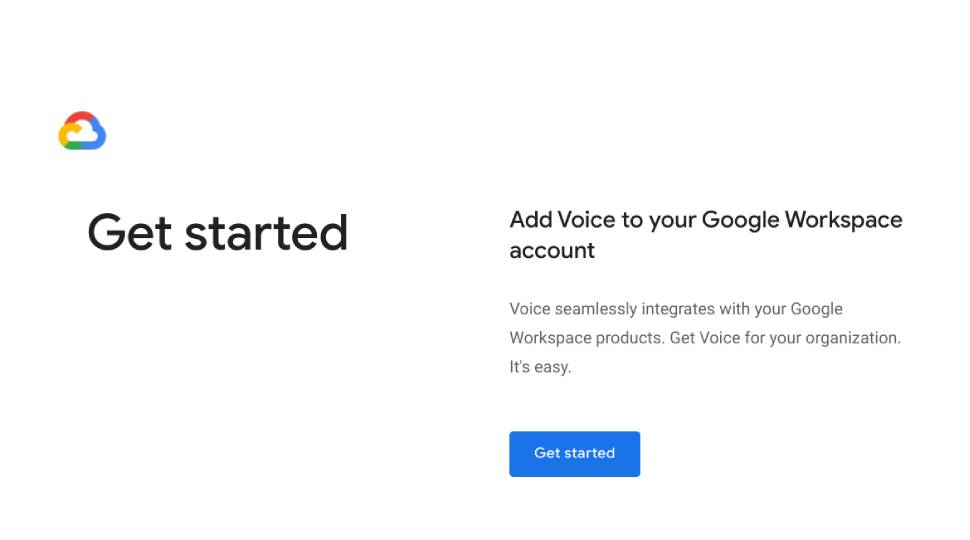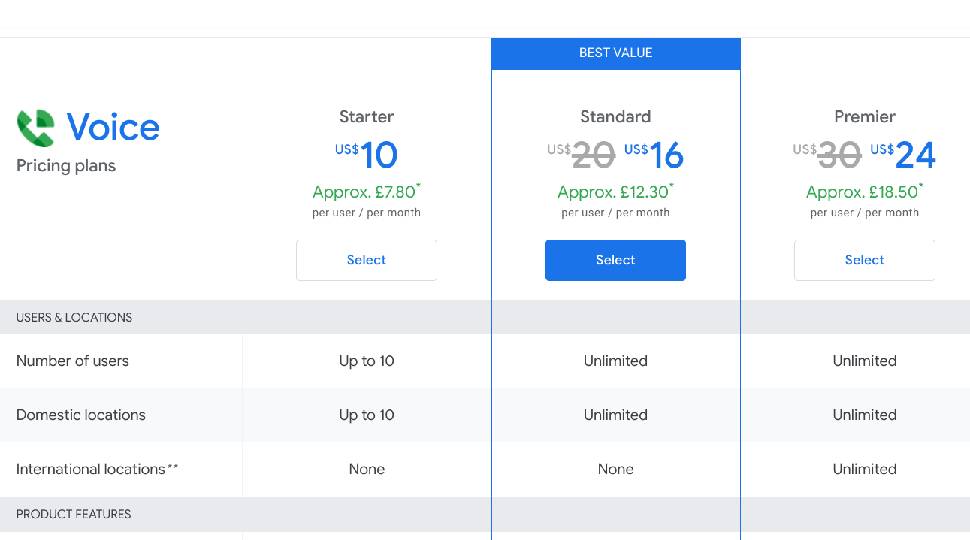Google Voice
From starting life as a research project developed by Larry Page and Sergey Brin when they were PhD students at Stanford University back in 1996 to becoming the world’s most popular search engine, the rise of Google has been truly stratospheric. Today, the tech giant dabbles in many fields, from cloud computing to smartphones, battling it out with other huge corporations like Apple, Facebook, and Microsoft.
This is our all-in-one roundup looking at the Google Voice VoIP service. On this page, after our brief intro, you’ll find
(a) a look at the Google Voice setup
(b) an examination of the platform's key features
(c) and an exploration of Google Voice's various pricing plans
You can jump to the review section that interests you most by clicking on the links in the bar at the top of this page, but bear in mind that this article is really designed to be read all the way through, as businesses will benefit from assessing the service in its entirety before deciding if it meets their needs.
Never seemingly afraid to enter into new markets, Google has been active in the VoIP space since 2009, which is when Google Voice was launched. Back then, Google Voice was largely based on GrandCentral, another VoIP service that Google had purchased for around $95 million a few years earlier. Much of GrandCentral’s functionality was retained under the new Google Voice brand, with new features like voice mail transcriptions and SMS management added.
Through its decade or so of existence, Google Voice has encountered several ups and downs. Shortly after its launch, it was rejected from Apple’s App Store because it replaced certain iPhone functions and features. Despite the setback, Google Voice was eventually accepted to the App Store in November 2010, where it has been available ever since.
As Google has tinkered with its business solution offering, the role played by Google Voice has also been affected. In 2014, for example, some Voice features were incorporated into Google Hangouts (a move that has since been undone), and then, in 2018, Google announced the release of Google Voice for existing Google Workspace customers in select countries, specifically targeting business users.
So Google Voice has had something of a storied history. Today, it finds itself up against tough competition in the VoIP space, with many more companies operating in the field than was the case back in 2009. To find out how Google Voice compares against its competitors, scroll down to read our detailed review.
- Best cloud phone systems: buy a business PBX system in the cloud
- Best business phone services
- The best VoIP phones for the small business and home office
Setup

Google Workspace, previously known as G Suite, comprises Google’s cloud computing, productivity, and collaboration tools. It includes apps like Gmail, Google Calendar, Google Docs, and, for the last couple of years at least, it has also worked with Google Voice.
Adding Voice to your existing Workspace account is straightforward. Workspace users first need to sign into their Google Admin console using an administrator account (be sure not to use a personal account if you have one). Then, from the Admin console, users should navigate to Apps, followed by Google Workspace. After that, click “Add Service,” and under Categories, locate Google Voice. It’s then simply a case of adding the subscription you want and following the on-screen instructions.
The general requirements for Google Voice are quite broad, so potential customers are likely to find that they are already using a compatible device. In terms of operating systems, for example, Google Voice works with the two previous major releases of Chrome OS, Apple Mac, Microsoft Windows, Android, and Apple iOS. In addition, Google Voice is compatible with the current release and one previous major release of the Chrome web browser, as well as the Microsoft Edge, Mozilla Firefox, and Safari browsers.
One of the great things about Google Voice is that it weakens the connection between a particular phone number and a specific device. As long as the number has been properly forwarded using the Google Voice platform, any device with the Voice app - be it a smartphone, tablet, or laptop - can be used to send and receive calls to your chosen number. It doesn’t matter what network or carrier-assigned number is associated with the device in question - you'll still be able to set up your business number with Google Voice.
This is great for when employees lose their phone, upgrade their device, or when somebody leaves a company and you want to retain their number. This can all be managed from the Google Voice centralized control panel.
So all-in-all, the installation for Google Voice is extremely straightforward, but Google does also provide advice for any business that is thinking about moving to Voice but has further questions about the kind of functionality they will receive.
Key features

As you’d expect from a VoIP solution provided by one of the biggest companies on the planet, Google Voice has many of the features that modern businesses demand from their office communications. For example, Voice gives businesses the freedom to pick their favorite number by entering a zip and the area code when registering for a Google Voice account. Smaller companies, in particular, are likely to appreciate this feature as it means they can choose a number that uses the same area code as most of their customers, giving their business more of a local fee.
In addition, Voice users can also send and receives calls or texts free of charge to domestic locations using Voice. Calls can be recorded simply by pressing “4” during a call and these recordings are easily found through the left sidebar. With so many meetings taking place remotely now, the ability to record calls and then review them at a later date is a great way of ensuring that important details are not missed just because workplace interactions are occurring face-to-face less frequently. Similarly, Voice also comes with voicemail transcription, which given Google’s advanced speech recognition tech, works a lot better than some of the alternatives on the market.
One of the more unique offerings within Google Voice is the ability to switch between connected phones while in the midst of a call. This is particularly useful for individuals that work in industries that require them to frequently be on the move. For example, with Voice, workers can start a call on their laptop while sitting at their desk and seamlessly transfer it to their smartphone when they have an appointment elsewhere that they need to travel to urgently. There’s no need to hang up or interrupt the conversation in any way.
It’s also worth noting that Google Voice is still evolving. Recently Google issued a minor update, adding new caller ID, missed call, and SMS message features to Voice. Now, users can learn why they might have missed a call and receive directions on how to make sure that it doesn’t happen again. Google has also made it easier for Voice users to switch calls over to their mobile network - which should help anyone that has a patchy Wi-Fi connection.
However, despite these recent additions, Google hasn’t always given Voice the attention it demands. Of course, this isn’t entirely surprising given the sheer number of different productivity and collaboration tools that Google is in charge of. Nevertheless, the company can't be completely absolved from some of the muddled messaging and branding that has prevented Voice from really taking off in the B2B VoIP space.
Pricing plans

Google Voice has three pricing plans to choose from: Starter, Standard, and Premier. The Starter plan costs $10 per user, per month, and is available for up to 10 users and across 10 domestic locations. Like all three plans, the Starter offering comes with free calling to the US from any country, free calling to Canada from the US, and unlimited SMS messaging in the US.
The Starter plan is compatible with Google Fi, the company’s platform offering improved network coverage and streamlined billing. In addition, customers can enjoy voicemail transcription, integration with Google Calendar and Google Meet, and access to mobile apps available on both the Android and iOS operating systems. There’s also a web application available, which means individuals can conduct calls from their tablet or laptop.
The Standard plan is slightly more expensive, being priced at $16 per user, per month for an unlimited number of users and domestic locations. In addition to all the features that come with the Starter plan, the Standard version of Google Voice also comes with a multi-level auto-attendant, which is great for larger firms where callers may want to talk to a specific individual. A ring groups feature is also available so multiple devices will ring at the same time, reducing the number of missed calls. And there's an eDiscovery option for calls, voicemail, and SMS records, so businesses will have access to deeper insights about their communications.
Finally, the Premier plan, which costs $24 per user, per month (and includes unlimited international locations), comes complete with everything offered by the Starter and Standard plans, plus advanced reporting (BigQuery). BigQuery is a fully managed enterprise data warehouse that helps companies manage and analyze their data with built-in features like machine learning, geospatial analysis, and business intelligence. Operated by Google Cloud, this feature is only likely to be used by bigger firms that want to leverage a large volume of calls to gather information. It’s a nice feature to have for the organizations that will use it, but it’s probably not going to tempt SMBs to opt for the higher-priced package.
Final verdict
At face value, Google Voice is not a bad VoIP platform at all. However, with Google’s reputation and the number of years that have passed since Voice launched, the solution does feel a little disappointing. Big data analytics are a nice touch, but smaller businesses may decide to choose flashier, better-marketed VoIP platforms - particularly if they are not heavy users of Google Workspace.
- We've also highlighted the best VoIP providers
0 comments:
Post a Comment